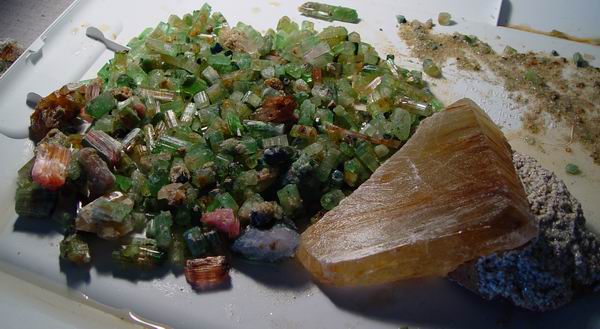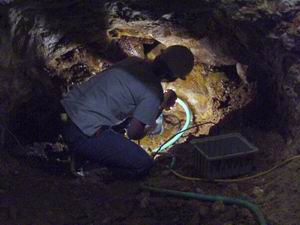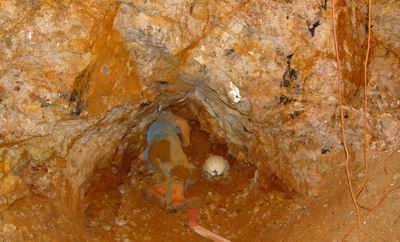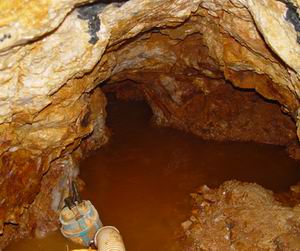

 |
 |
| Mining Operations at Mount Mica & Orchard Pit Mines, Oxford County, Maine. | |

Once
we had finished our hand mucking after the roof was blasted, we could
properly dig this new chamber. Its walls were coated with
quartz crystals, some with overgrowths. In the pocket material on the
floor there were numerous small gemmy green tourmalines. It was
apparent now that our bright pink tourmaline was the terminal end of a
large schorl that had penetrated into the pocket from overhead in the
roof. There were many other schorl stubs in the roof and walls so our
hopes were buoyed we would find other large tourmalines or pieces there
of. The
volume of
material coming out of this cavity soon overwhelmed both the trusty
round screens we had used in the past and the screen table we had built
for MMP28-04. Jim made a double deck screen 8' x4'. Now others were
required to help Jim screen the material. ( In the picture to
the right Missy Robbins, one of the people helping screen, looks into
pocket MMP11-05. Note the large
quartz crystal with overgrowth still in place in the roof) chamber. Its walls were coated with
quartz crystals, some with overgrowths. In the pocket material on the
floor there were numerous small gemmy green tourmalines. It was
apparent now that our bright pink tourmaline was the terminal end of a
large schorl that had penetrated into the pocket from overhead in the
roof. There were many other schorl stubs in the roof and walls so our
hopes were buoyed we would find other large tourmalines or pieces there
of. The
volume of
material coming out of this cavity soon overwhelmed both the trusty
round screens we had used in the past and the screen table we had built
for MMP28-04. Jim made a double deck screen 8' x4'. Now others were
required to help Jim screen the material. ( In the picture to
the right Missy Robbins, one of the people helping screen, looks into
pocket MMP11-05. Note the large
quartz crystal with overgrowth still in place in the roof) As we worked our way to the back of this chamber, we could see it appeared to end in a curtain of quartz crystals growing down towards the floor. With a little digging we could get our fingers underneath  their points. There was at
least a small space ahead. It was more than the back wall of the
pocket. This part of the operation had taken us several days and again
we found ourselves either kneeling or lying down to dig the back of the
pocket.
Once more we decided to
drill the roof and put in a small blast in order to expand our head
room. their points. There was at
least a small space ahead. It was more than the back wall of the
pocket. This part of the operation had taken us several days and again
we found ourselves either kneeling or lying down to dig the back of the
pocket.
Once more we decided to
drill the roof and put in a small blast in order to expand our head
room. The small blast we made easily shattered the quartz, both massive and crystal, in the roof of our pocket. Again we had to manually dig out a very large amount of muck. As we dug to the back, it was apparent that the back wall of the chamber was really just a group of quartz crystals in front of another chamber still. This one appeared to be the same size as the chamber we had just dug. After a few hours of muddy wet digging, we could probe sizable spaces that went to the back and to the left and right. ( In the image to the left, Richard squirms in across the muck pile to have a first look into the new cavity. Notice the many rusty cracks around the pocket and the schorl stubs in the roof) It took us several days to dig this new chamber and its radiating arms. Each day produced a Kg or so of small tourmalines such as the ones pictured at the top of the page. We also found our first significant beryl since MMP10-04.  This new beryl is
also pictured at the top of the page. Yet again we found ourselves
working
in uncomfortable conditions. Water was a continuing nuisance and this
coupled with the rust covering everything made for some dirty miners.
The picture below shows what greeted us on the morning of
July 25. Our electric pump is setup removing the water accumulated
overnight. We had been working the smaller chamber visible near the
center of the picture. By laying on our sides, we could dig the space
to certain degree. We were intrigued by the smaller hole at the very
back. Richard, by using his foot, was able to shove our
standard measure hoe handle all the way in. This told us there was even
more digging head of us. We decided to do our 3rd roof shot into this
pocket so we could at least kneel to dig. We were concerned that this
pocket would be like MMP11-04 which,
though nearly 4 meters long, seldom was more then .6m high. We decided
to gamble a little and drill and blast a single hole but make it long
enough to be well above the far back chamber probed with the hoe. This
task proved to be more difficult than we thought as each of the spots
we
drilled intercepted space behind. We eventually were able to drill a
short hole nearly centered above the intermediate cavity and a
short
distance beyond. This new beryl is
also pictured at the top of the page. Yet again we found ourselves
working
in uncomfortable conditions. Water was a continuing nuisance and this
coupled with the rust covering everything made for some dirty miners.
The picture below shows what greeted us on the morning of
July 25. Our electric pump is setup removing the water accumulated
overnight. We had been working the smaller chamber visible near the
center of the picture. By laying on our sides, we could dig the space
to certain degree. We were intrigued by the smaller hole at the very
back. Richard, by using his foot, was able to shove our
standard measure hoe handle all the way in. This told us there was even
more digging head of us. We decided to do our 3rd roof shot into this
pocket so we could at least kneel to dig. We were concerned that this
pocket would be like MMP11-04 which,
though nearly 4 meters long, seldom was more then .6m high. We decided
to gamble a little and drill and blast a single hole but make it long
enough to be well above the far back chamber probed with the hoe. This
task proved to be more difficult than we thought as each of the spots
we
drilled intercepted space behind. We eventually were able to drill a
short hole nearly centered above the intermediate cavity and a
short
distance beyond. After the blast we set up our ventilation system to clear the fumes and then waited impatiently to see the the results of our work. After 5 minutes or so, the fumes were cleared enough from this small blast to allow us to examine the results. Using our high intensity latern, I crawled into the enlarged space. At the back was only blackness.... we had opened a huge chamber. The pocket went both left, right and straight ahead as far as I could extend our 2m loading pole. The pocket was filled nearly to the ceiling with feldspar and quartz crystals that eons ago had dropped from roof most probably from their own weight. However, at the back and to each side many were still attached with their points radiating inward.
There was perhaps .6m clearance between the top of the pocket material and the ceiling. We some trepidation each of us took a turn crawling in to survey the scene. Our fear was that a piece of feldspar might slough from the roof pinning one of us in side. Our first estimate was the pocket extended for 4-5 meters straight in and a similar amount to both the left and right. We had no idea as to how deep the pocket was. In fact, to the right, the debris was piled so high and so tightly against the ceiling we could not see over it. By moving a few pieces of feldspar, Frank Perham, the most adapted of our group to see over the pile, worked his way over the top and reported it went for another 'honest 10 feet'. This pocket would take some serious digging. Go to page: 1, 3, 4 |
||||